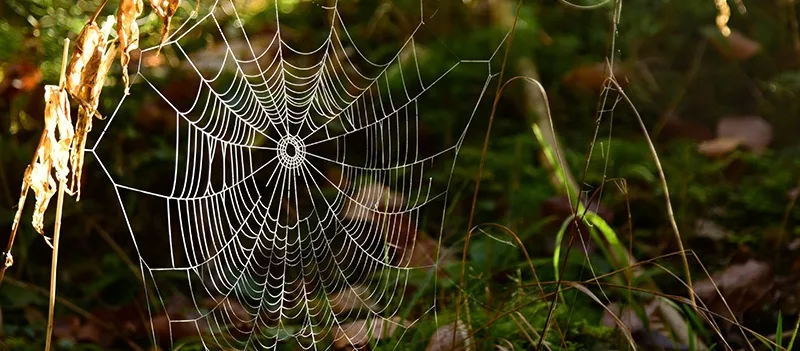
How To Get Rid Of Spiders
March 5, 2024
Spiders are one of the most common household pests, making them a nuisance for just about any homeowner. When spiders start to emerge indoors, many people want to know how to kill them. DIY Pest Control has the answers you need!
We will discuss using spider spray and pesticides to get rid of these pests and will also provide tips on preventing spiders from entering your home in the first place.
Unfortunately, there are no shortcuts to getting rid of spiders. Just like with other pests and insects, success comes through the persistent application of insecticides and the effective methods listed throughout this article.
Insecticide dusts, aerosols, and Spider traps are three of the most effective methods for getting rid of spiders around the home. Once you have controlled the spiders, you will need to continue to monitor the area for re-infestation.
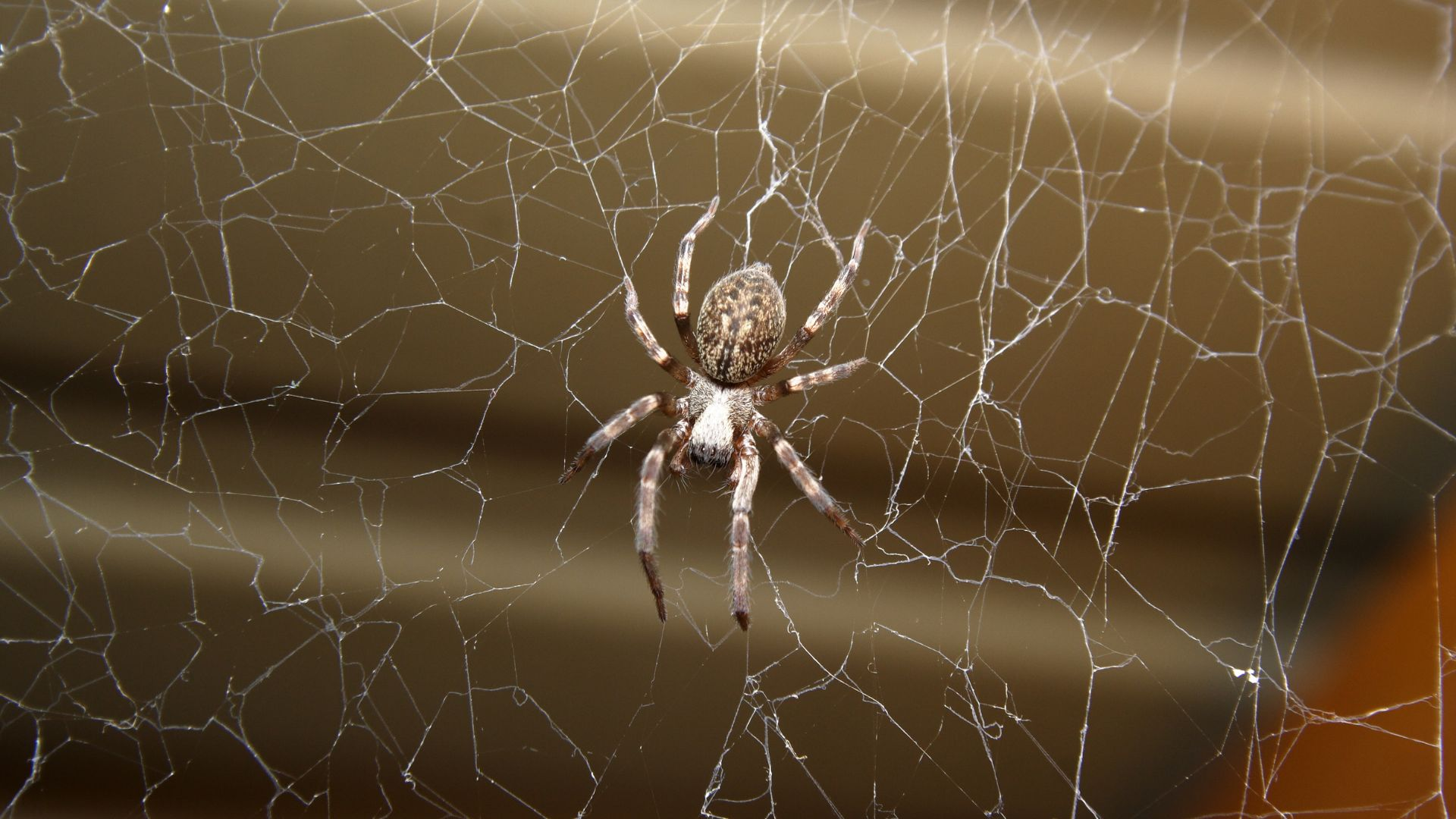
Identifying Spiders - General Characteristics
Many species of spiders are common household pests in the United States. Spiders are considered beneficial pests because of their prey to other insects.
Because spiders have eight legs, they are easy to separate from insects, which have only six legs.
The United States is home to more than 3,000 different species of spiders. Most of them are harmless. However, there are some species that should raise alarms if you see them. Here are some commonly found, dangerous spiders:
Brown Recluse Spiders
The Brown Recluse is one of the most common yet dangerous household spiders in the U.S. The body is yellow to dark brown, with a body size of 1/3-1/2 inches long. Combined with the legs, it could be about 1 inch or longer in diameter. The dorsal has a dark brown violin-shaped marking, very distinctive.
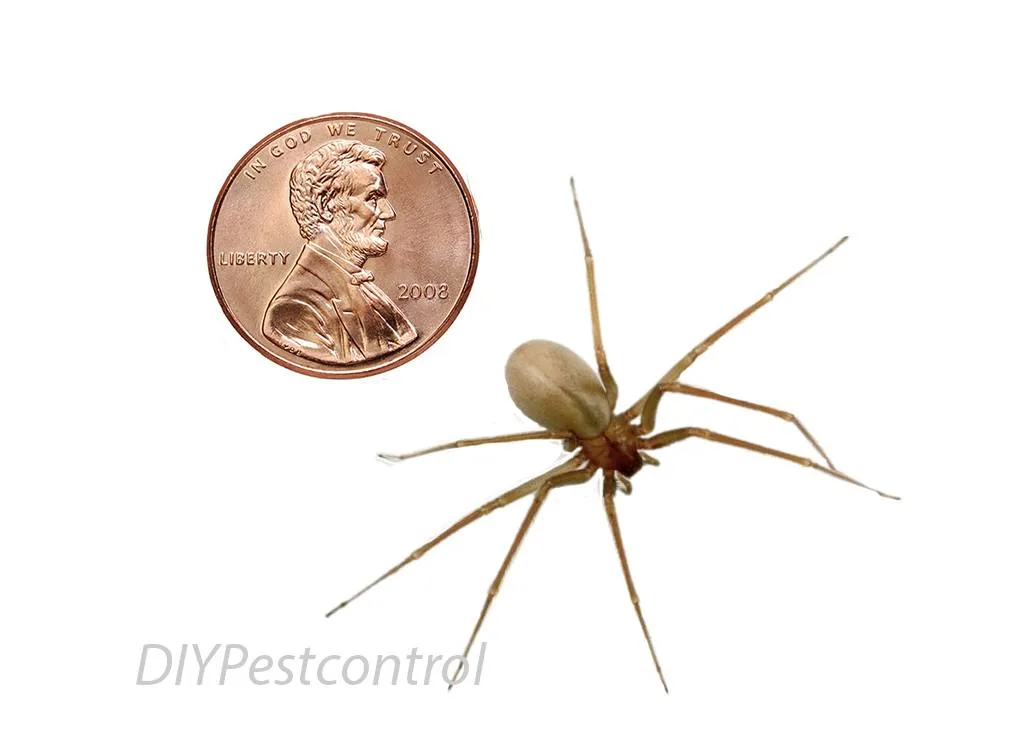
Their web is off-white to gray. They can be found outside, under rocks, debris, woodpiles, etc. However, they are often found inside. Brown Recluse spiders can be found in storage areas like closets, basements, bathrooms, bedrooms, attics, garages, and cellars. Sometimes, they can be around above the ceiling ductwork or register. When inspecting for Brown Recluse spiders, use gloves and a flashlight.
Brown Recluse likes to stay hidden and can be a difficult spider to get rid of. Many times, people get bit by putting their hands or feet in something that has been in storage.
You should always wear gloves when handling debris outside the home. The initial bite is not intense but poisonous.
Click here for more information on The Brown Recluse Spider
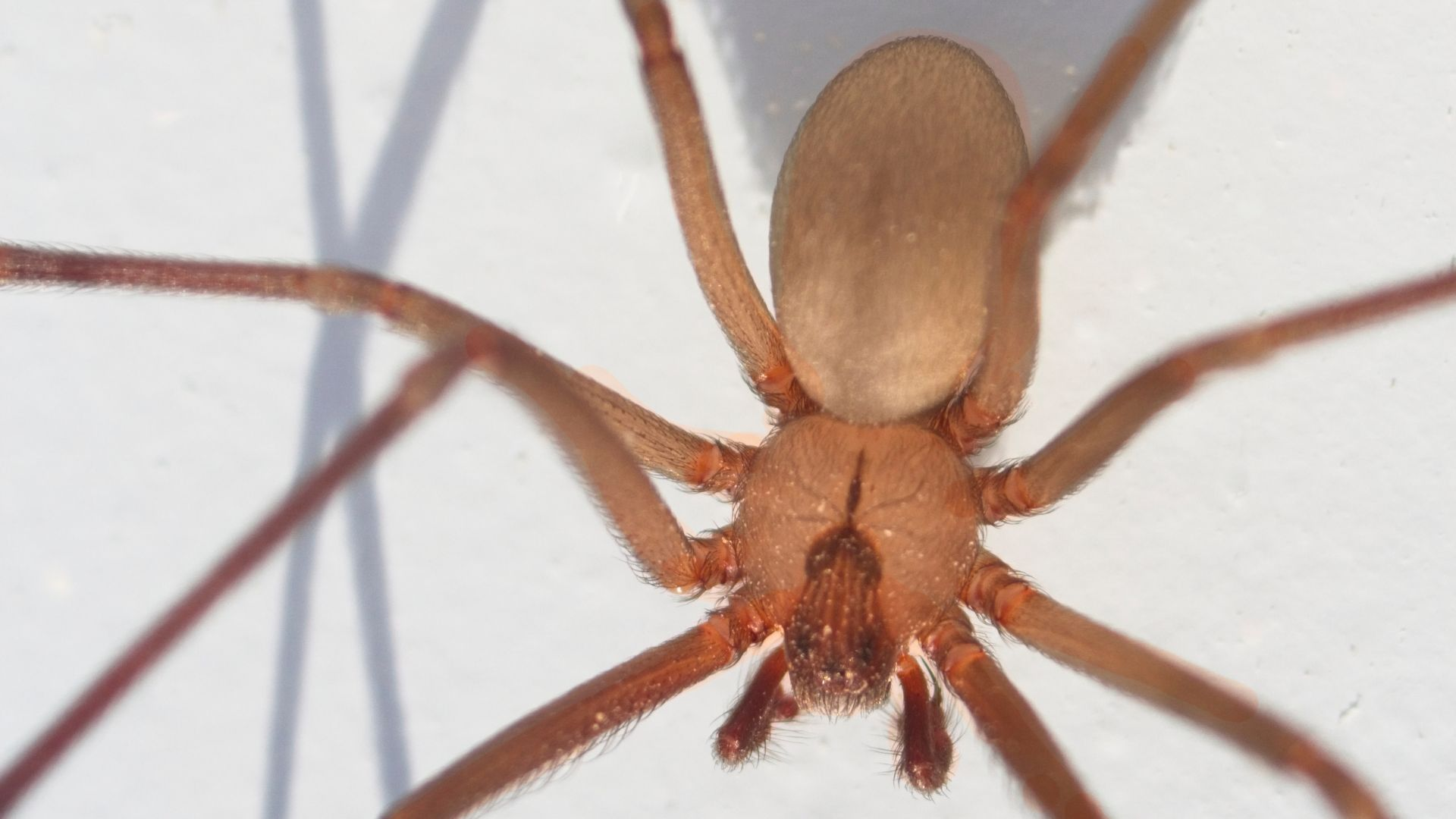
Black Widow Spiders
Black widow spiders are possibly the most well-known species of spiders, thanks to their venomous bite. The female has a shiny black, globular abdomen with two yellow or red markings in a triangle shape. It looks like an hourglass.
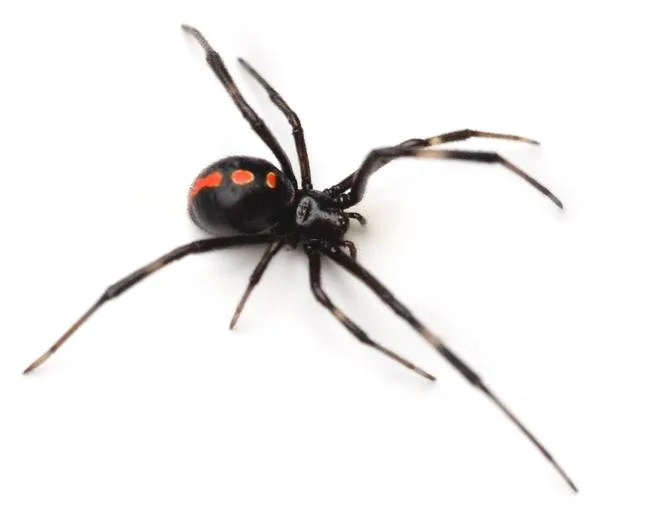
Males are smaller and lighter in color, with light streaks on the abdomen.
The web is irregular, many times found along exterior foundations on slabs, under stones and rocks, and behind shrubs.
The good news; they usually don't enter structures.
Black Widow’s will bite if provoked. Spider bites feel like a sharp pain, like a needle puncture. After 15 minutes to an hour, there will be muscular cramps.
Black Widow Spider bites are rarely fatal, but you should seek medical attention.
Click here for more information on Black Widow Spiders
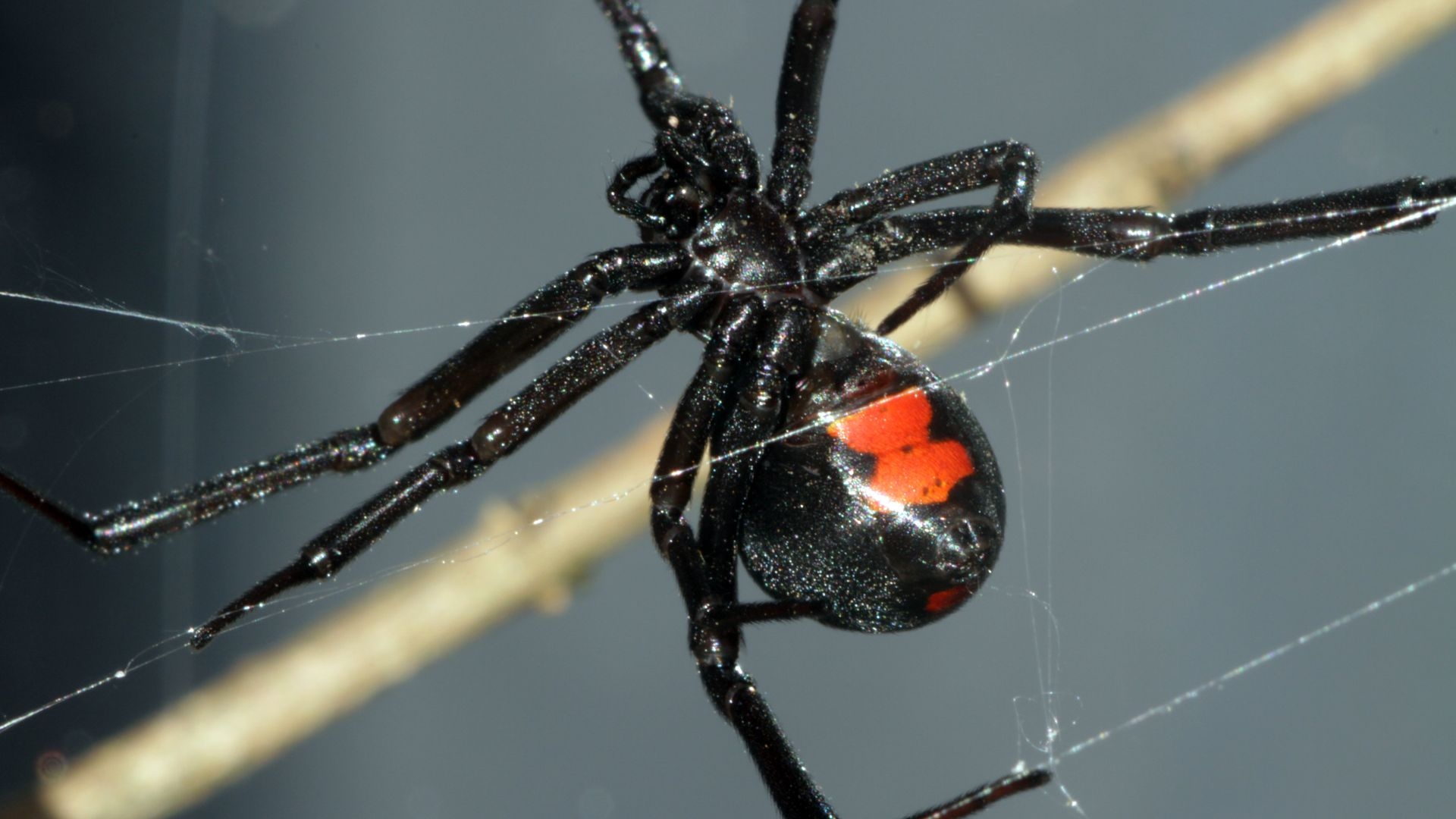
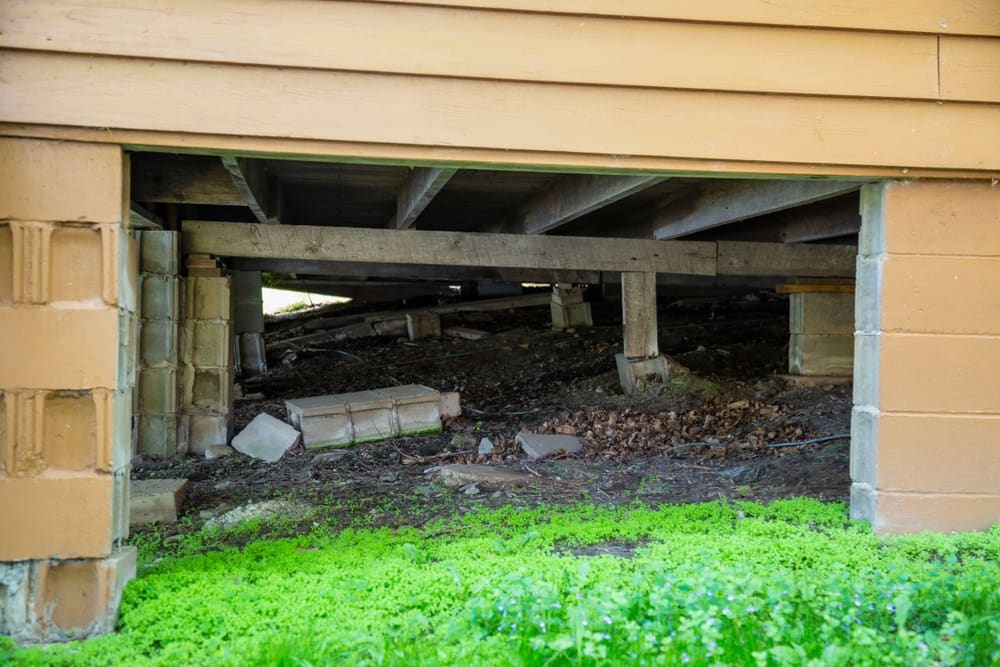
Locating Spiders
Some Spider populations are found in humid and moist locations like basements and crawl spaces. Other Spiders prefer dry and warm places. They can typically be found in the upper corners of rooms and attics, as well as sub-floor air vents.
Spiders prefer to hide in dark areas and in cracks as a retreat to construct material for their webs. If you suspect a spider infestation, start your search in these places around your home!
Get Rid of Spiders Inside Your House
There are a wide range of solutions to eliminating spiders from your home. Here are some of our top tips to immediately get rid of spiders in your home:
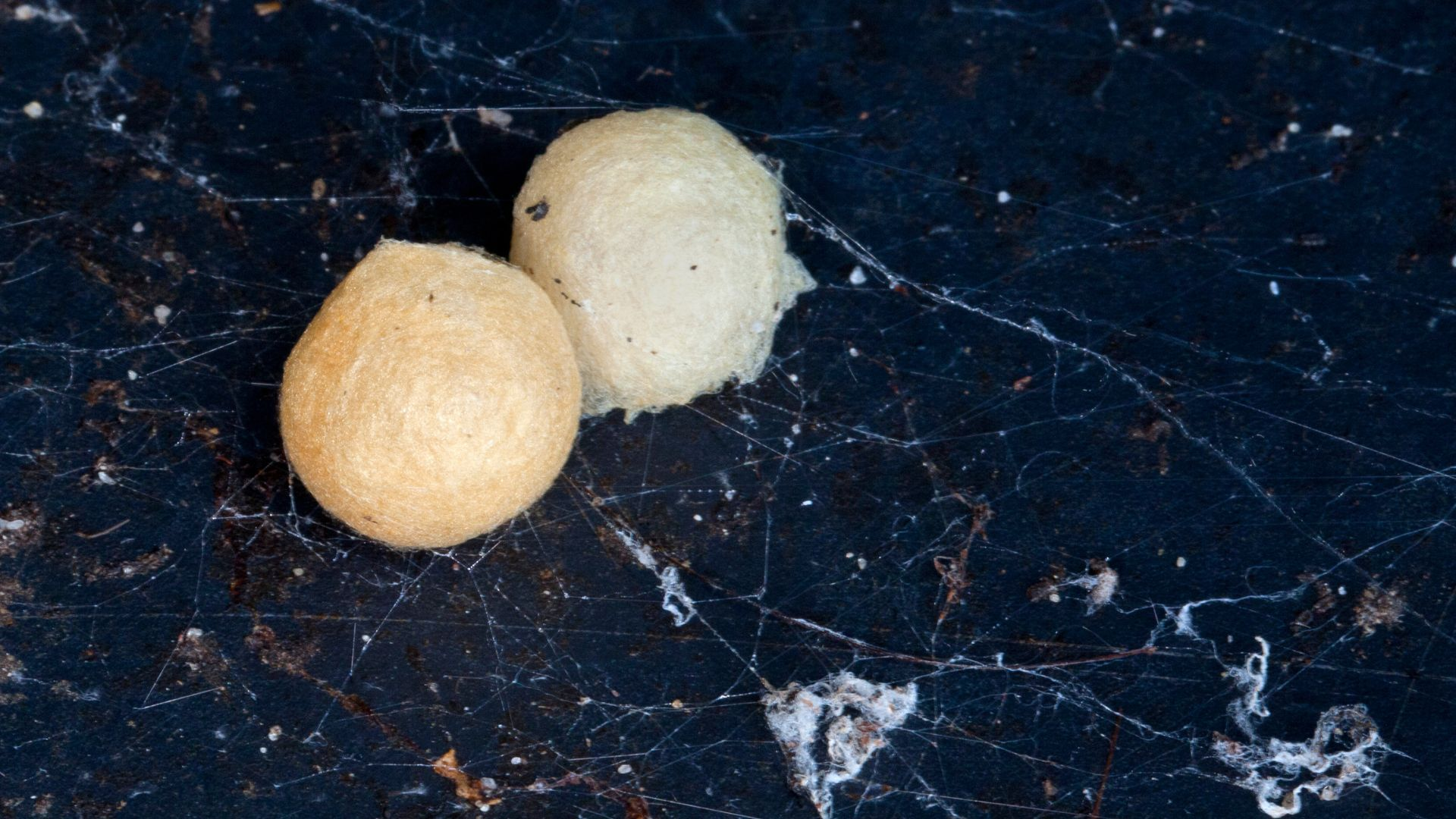
Use Spider Traps
Sticky traps are an efficient, low-maintenance way to get rid of Spiders, especially Black Widows and Brown Recluse spiders. If you place these traps in areas where you have noticed spider activity, you should be able to control the spider population in your house.
You can find spider traps at your local hardware store, garden store, or you can even make one yourself. Be sure to keep them out of reach of children and away from your household pets.
Trapper LTD Insect Glue Boards will catch spiders and monitor the population.
The Monterey Spider Trap will catch spiders and serve as a monitoring tool.
Get Rid of Spider Webs
Without a place to live or hide, spiders will have a hard time infesting your home. Some spider species build their web in dark corners, attics, and basements.
As soon as you spot spider webs in your home, use a duster or a vacuum to remove it.
Use a Spider Killer Spray
If you have a serious spider infestation, natural preventative methods may not be effective. As a more effective alternative, we recommend using an Indoor Spider killer Spray.
Keep in mind that the chemicals used in these sprays can be harmful to children or pets, so be sure to read the instructions before use. Aerosol spray kills spiders in unwanted areas like under furniture, in the corners of your house, or on window frames.
Try a Spider Catcher
If you do not want to kill spiders in your home, there are other alternatives. A spider catcher wand has soft bristles to pick up spiders without harming them.
The extendable arm will reach places you can’t get to, which means you do not have to have direct contact with spiders. Now you can catch and release spiders or other bugs that enter your home.
These tools are simple to use for anyone. All you need to do is scoop up the spider with the mouth of the tool, then transport the spider outside and set it free.
How to Get Rid of Spiders Outside the Home
While spiders may be intimidating to see outside of your home, there are plenty of reasons why you should keep them around. Spiders' main source of food is insects, so if your house is infested by other pests, killing spiders may add to the problem. A healthy spider population will help keep insects to a minimum around your home.
If you do need to get rid of spiders outside your home, DIY Pest Control has several suggestions.
Use Insecticides to Get Rid of Spiders: Use store-bought insecticide sprays formulated for spiders around your garden yard, outbuildings, and deck.
These outdoor spider sprays kill spiders on contact and can be an effective method for treating spider infestations. Be sure to use sprays carefully, wear protective clothing, and follow all label directions.
Remove Cobwebs: Getting rid of spider webs will motivate spiders to move elsewhere without having to kill them.
Remove spider webs in your yard, on your porch, or on the outside of your house as soon as you notice them, and you will be well on your way to controlling your spider infestation.
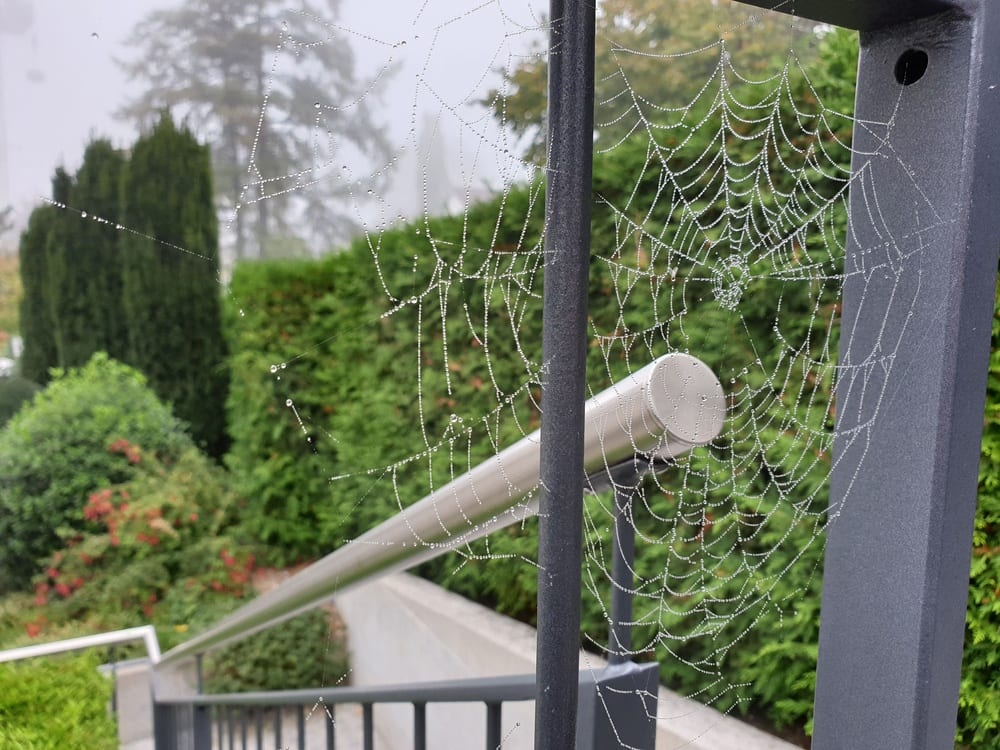
Best Insecticides to Kill Spiders
Pest Control Subscriptions
For long-lasting, comprehensive relief from spiders and other pests, consider a pest control subscription, like Riddy.
These subscriptions provide a plan that is custom-made to your home and location. You'll receive scheduled shipments with easy-to-follow instructions so you can take your home's pest control into your own hands.
Insecticide Concentrates & Aerosols
Perimeter Spray Treatment - If spiders are coming indoors, hunting for their prey, spray a residual insecticide treatment such as Onslaught Fastcap Spider and Scorpion Insecticide around all entry points and the perimeter of your house. Spray anywhere there is webbing: on decks, under eaves, on porches, and other areas on the exterior of buildings
Indoor Spray Treatment - to get rid of spiders inside your home, spray along baseboards, in corners, and under furniture. Use an insecticide aerosol like PT221L Aerosol with a crack and crevice tip to spray along baseboards, window and door frames, corners, pipes, and other areas where spiders may crawl. These aerosols are convenient to spray in areas where a water-based product can not reach them.
We have a kit with Onslaught Fastcap Spider and Scorpion Insecticide and PT 221L Aerosol in one kit called the Residential Spider Kit.
Use the Onslaught Fastcap outside (it may be sprayed inside as well), and the PT221L Aerosol with its crack and crevice tip is used to spray into hiding places where the liquid can not reach.
Other Suggested Insecticide Concentrates
Avesta CS - Micro-encapsulated; spray inside and outside. It adheres well to surface areas and is ideal for perimeter treatments around structures.
Cyper WSP - Wettable powder; may be used inside or outside.
Key Takeaway
Remove spider webs before applying the insecticide. This will force the spiders to contact the treated surfaces as they attempt to rebuild their web.
Suggested Aerosols
-
D-Force HPX Aerosol - With crack crevice tip - Lasts 4-8 weeks.
-
Stryker 54 Contact Spray - This pyrethrin aerosol spray is used for killing spiders on contact and flushing them out of hiding places.
Insecticide Dusts ‐ Additional Treatment
For a large spider problem, use insecticide dusts like Cimexa Dust and D-Fense Dust in the attic areas. Other areas that can be dusted include wall voids and under baseboards with hand dusters.
A Cobweb Duster Head can be placed on a standard pole and used to get rid of spiders in tricky spots. The brush head will hold the dust in place; brush it in places where the spiders make their webs.
Place insecticide dust on the head and spread it into the corners of your basement, garage, and porch areas.
For large areas, use Dustin Mizer Duster. Dustin Mizer cranks out a lot of dust for excellent coverage in attics.
Prevent Further Spider Infestation
1. Reduce Favorable Spider Conditions Outside
To get rid of spiders, remove infestation sources such as clutter in the yard, crawl spaces, and any ground covers against the foundational walls.
The first step in spider control is to remove favorable conditions for spiders. Getting rid of other insects with a routine insecticide treatment should be a high priority as insects are a spider's main food source. An excess of insects around your home attracts spiders because spiders eat mainly insects.
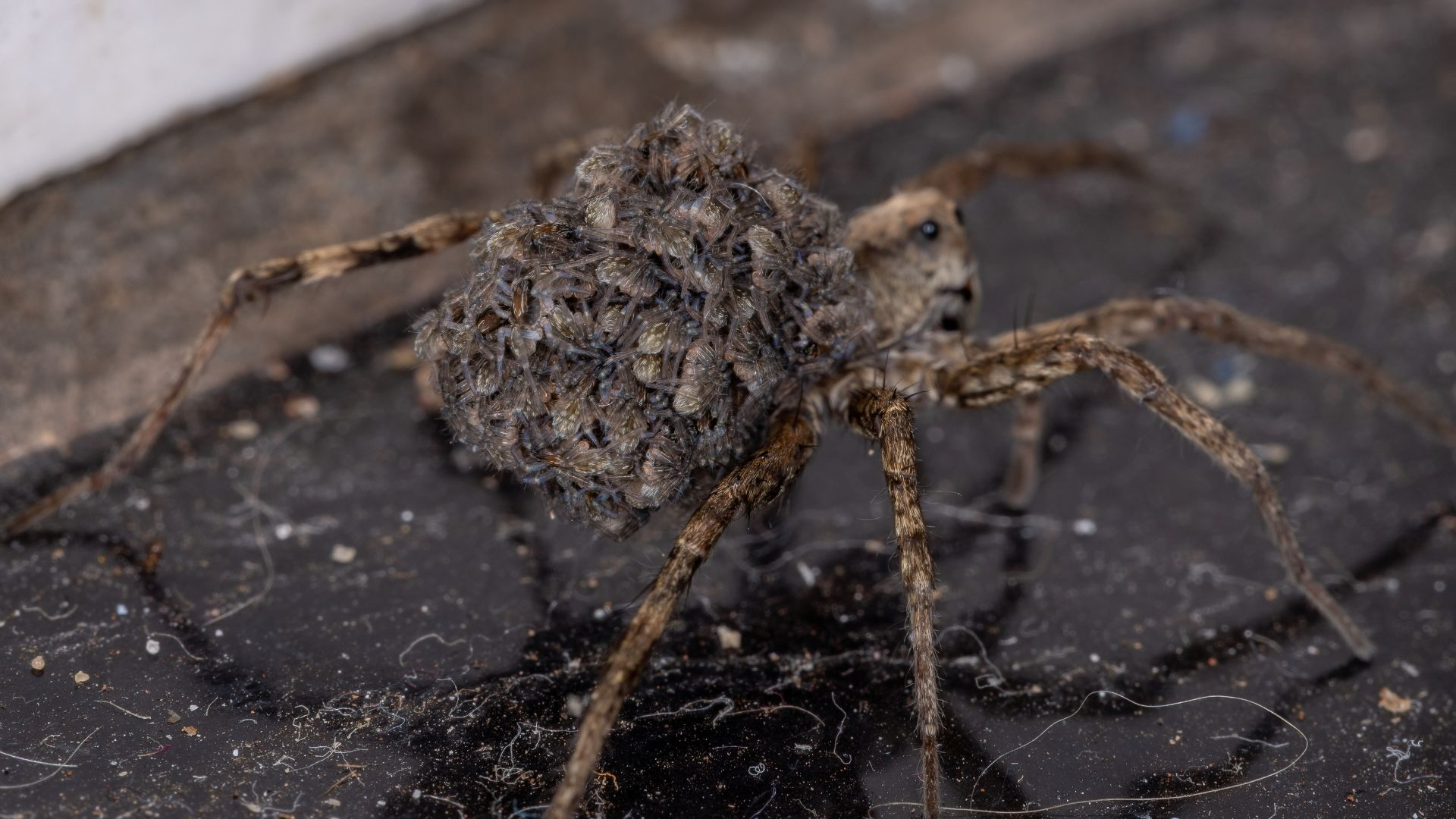
JT Eaton Webster Cobweb Duster Head is convenient for cleaning cobwebs and is used as an applicator tool for insecticide dust. This head can be placed on any standard threaded pole found at your local home improvement store.
Web Out is a natural product that not only removes spider webs but repels spiders as well. It will last 5-6 months inside and 2‐3 months outside.
Key Takeaway
Remove yard clutter and debris near the house and cut back any vegetation against exterior walls.
2. Keep Your Home Tidy
A clean house makes it harder for spiders to hide. Vacuuming and dusting on a regular basis can help to prevent spiders. Food leftovers are one of the main reasons that your house would become infested by spiders or other bugs.
Make sure you wipe down benches, wash your dishes, and keep your kitchen free of food scraps if you have a spider infestation.Food leftovers attract bugs, and because spiders eat insects, crumbs and food scraps indirectly attract spiders.
3. Try a Natural Remedy
If you are looking for a natural alternative to prevent spiders, you will find several home remedies that can do the job.
Peppermint oil is known to discourage most spiders due to its strong smell. Add several drops of peppermint oil to water in a spray bottle and spray it anywhere you see spiders in your home.
Another option is to use Vinegar to get rid of spiders. Most spiders are repelled by the scent of vinegar. If you see webs or spider activity, using a spray bottle, spray a mix of water and vinegar on the area. Apply every few days, and your spider infestation will ease.
4. Use Plants that Repel Spiders
There are several plants that will repel spiders if you plant them in your yard or around your house. Plants like Eucalyptus will help to keep most spiders away from your home.
Another natural alternative that can be used to kill spiders is a type of fossilized algae (diatomaceous earth). You can spread this around your garden or yard in an attempt to get rid of spiders.
Spider Control Products & Solutions
At DIY Pest Control, we understand the urgency and importance of a spider-free home. That's why we've curated a selection of top-tier spider control products, each designed to offer quick, effective, and easy-to-use solutions for your spider concerns. From natural repellents to advanced traps and sprays, our products are tailored to ensure your peace of mind and the safety of your home. Don't let spiders take over — take control and transform your space into a comfortable, spider-free haven. Order now and experience the difference of expert solutions at your fingertips!
Shop Spider Control ProductsHow to Get Rid of Spiders
Learn how to kill spiders with spider spray and pesticides.
Spider Control Steps
Sanitation: Reduce Favorable Spider Conditions
-
JT Eaton Webster Cobweb Duster Headis convenient to clean cobwebs and used as an applicator tool for insecticide dust. This head can be placed on any standard threaded pole found at your local home improvement store.
-
Web Out is a natural product that not only removes the spider webs but repels the spiders as well. It will last 5-6 months inside and 2‐3 months outside.
Remove some infestation sources such as clutter in the yard and crawl spaces and any ground covers against the foundational walls. Any sanitation step to remove favorable conditions is the first step in spider control. Getting rid of other insects with a routine insecticide treatment should be considered since other insects are their food sources.
Key Takeaway
Remove yard clutter and debris near the house and cut back any vegetation against exterior walls.
Insecticide Concentrates & Aerosols
- Perimeter Spray Treatment - If spiders are coming indoors, hunting for their prey, spray a residual insecticide treatment such as Onslaught Fastcap Spider and Scorpion Insecticide around all entry points and the perimeter of your house. Spray anywhere they are webbing, on decks, under eaves, on porches, and other areas on the exterior of buildings.
- Indoor Spray Treatment - Spray along baseboards, in corners, and under furniture. Use an insecticide aerosol like PT221L Aerosol with a crack and crevice tip to spray along baseboards, window and door frames, corners, pipes, and other areas where spiders may crawl. These aerosols are convenient to spray in areas where a water-based product can not reach.
- We have a kit with Onslaught Fastcap Spider and Scorpion Insecticide and PT 221L Aerosol in one kit called the Residential Spider Kit. Use the Onslaught Fastcap outside (it may be sprayed inside as well), and the PT221L Aerosol with its crack and crevice tip is used to spray into hiding places where the liquid can not reach.
Suggested Insecticide Concentrates
- Onslaught FastCap - Microencapsulated; fast-acting; may be used inside or outside.
- Avesta CS - Micro-encapsulated; spray inside and outside. It adheres well to surface areas and is ideal for perimeter treatments around structures.
- Residential Spider Kit Use the Demand CS Insecticide as a residual liquid spray on the outside. It has little to no odor and adheres very well to surfaces. Use the PT 211L Aerosol with its crack and crevice tip to cracks and crevices both inside and outside. Spray where spiders or spider webs have been found.
- Cyper WSP - Wettable powder; may be used inside or outside.
Kill Spiders and Insects ‐ Insecticides
Monitoring with Spider Traps
Trapper LTD Insect Glue Boards will catch spiders and monitor the population. The Monterey Spider Trap will catch spiders and serve as a monitoring tool.
Key Takeaway
Remove spider webs before applying the insecticide.
This will force the spiders to contact the treated surfaces as they attempt to rebuild their web.
General Spider Characteristics
Many species of spiders are common household pests in the United States. Spiders are considered beneficial pests because of their prey to other insects. Because spiders have eight legs, they are easy to separate from insects, which have only six legs. Another distinction between spiders and other pests is that spiders do not have wings or antennae. Spiders are arachnids.
To kill their prey, all spiders use venom. Not all spiders are dangerous to humans. If Black Widow Spiders and Brown Recluse Spiders, Hobo Spiders, and European House Spiders are found, pest control treatment should be considered. These spiders do not create spider webs indoors. Although there is generally little danger resulting from spider bites from most spiders, it is advisable to consult a physician for spider bites.
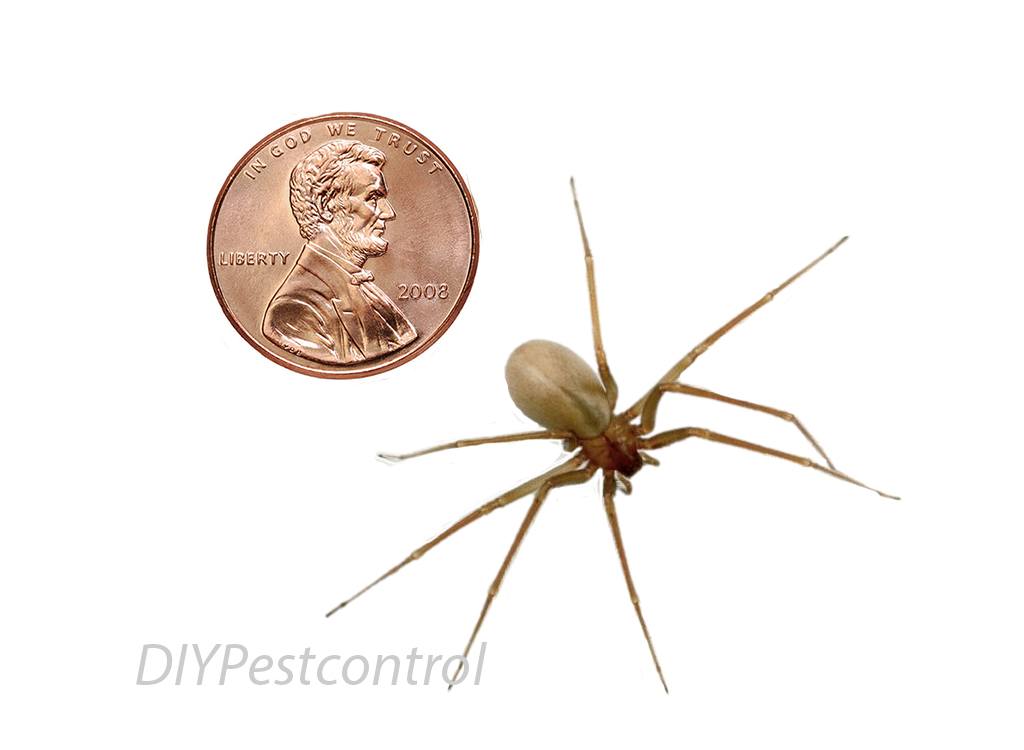
Brown Recluse Spiders
The body is yellow to dark brown, with a body size of 1/3-1/2 inch long. Combined with the legs, it could be about 1 inch or longer in diameter. The dorsal has a dark brown violin-shaped marking, very distinctive. Their web is off-white to Gray. They can be found outside, under rocks, debris, woodpiles, etc. However, they are often found inside Brown Recluse spiders can be found in storage areas like closets, basements, bathrooms, bedrooms, attics, garages, and cellars. Sometimes they can be around above the ceiling ductwork or register. When inspecting for Brown Recluse spiders, use gloves and a flashlight. Brown Recluse likes to stay hidden. Their webs are off-white to gray colors, and they are not extensive. Many times people get bit by putting their hands or feet in something that has been in storage. You should always wear gloves when handling debris outside the home. The initial bite is not intense but poisonous.
Click here: Brown Recluse SpidersFor more information on black widow spiders.
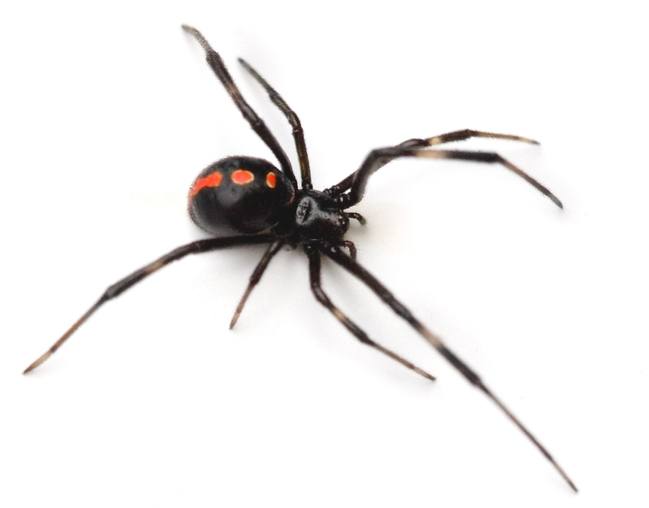
Black Widow Spiders
The female has a shiny black, globular abdomen with two yellow or red markings in a triangle shape. It looks like an hourglass. Males are smaller, lighter in color, with light streaks on the abdomen. The web is irregular, many times found along exterior foundations on slabs, under stones and rocks, behind shrubs. They usually don't enter structures. They will bite if provoked. The bite feels like a sharp pain, like a needle puncture. After 15 minutes to an hour, there will be muscular cramps. Bites are rarely fatal, but you should seek medical attention.
Click here: Black Widow Spiders For more information on black widow spiders.
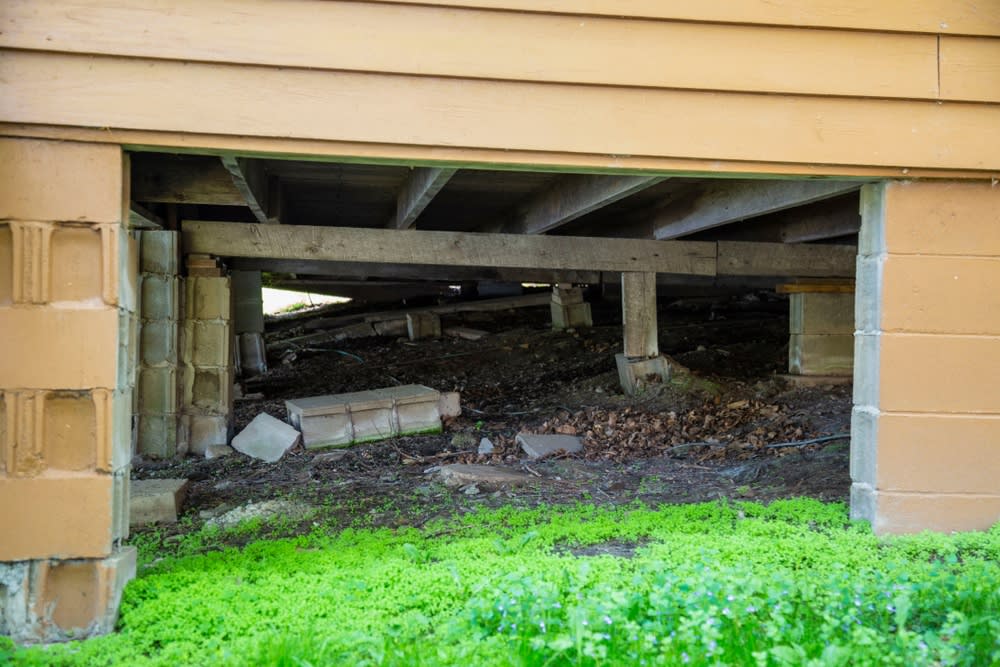
Location of Spiders
Some Spider populations are found in humid and moist locations like basements and crawl spaces. Other Spiders prefer dry and warm places. They can be found in upper corners of rooms and attics as well as sub-floor air-vents. Spiders prefer to hide in dark areas and in cracks as a retreat to construct material for their webs.
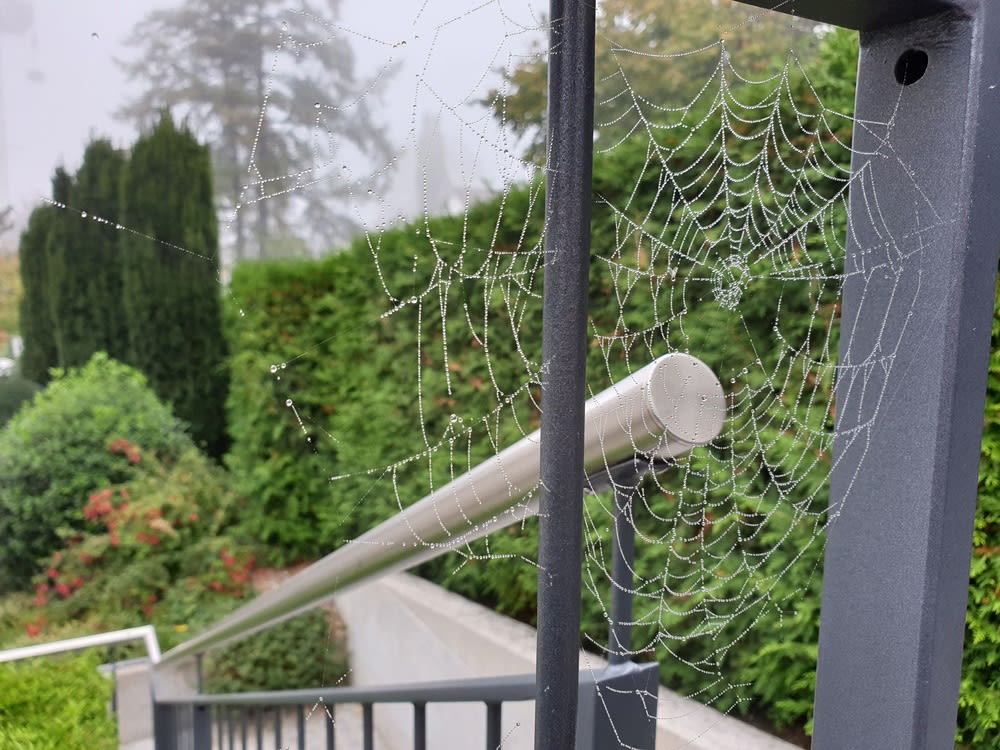
Spider Webs (Cobwebs)
Some species web over lamps in corners, attics, and basements. A spider made every "cobweb."
Suggested Aerosols
- PT211L Aerosol - The PT 221L has a long residual and excellent knockdown; it is a good all-purpose spray with a low odor.
- D-Force HPX Aerosol- With crack crevice tip- Last 4-8 weeks.
- Stryker 54 Contact Spray - This pyrethrin aerosol spray is used for killing spiders on contact and flushing them out of hiding places.
Insecticide Dusts ‐ Additional Treatment
For a large spider problem, use an insecticide dust like Cimexa Dust, D-Fense Dust in the attic areas. Other areas that can be dusted include wall voids and under baseboards with hand dusters
We also carry a Cobweb Duster Head to be placed on a standard pole. The brush head will hold the dust in place; brush it in places where the spiders make their webs. Place insecticide dust on the head and reach the corners in the basement, garage, and porch areas.
- For large areas, use Dustin Mizer Duster. Dustin Mizer cranks out a lot of dust for excellent coverage in attics.
Written by our resident pest control expert Ken Martin.




